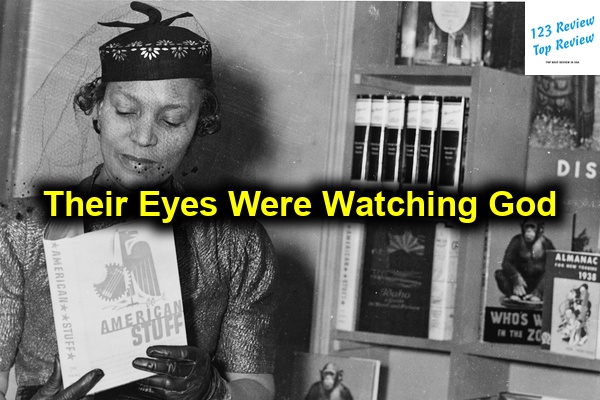Their Eyes Were Watching God delves deeply into the life of Janie Crawford as she navigates love, independence, and self-discovery. Set against the backdrop of the early 20th century in the southern United States, the novel weaves together themes of gender, race, and nature, creating a rich tapestry of narrative and symbolism.

In this article, 123 Review will explore the key themes and motifs, conduct character analysis, examine Hurston’s literary techniques, and contextualize the novel within its historical and cultural landscape.
Key Themes and Motifs
Gender Roles and Women’s Independence
A central theme in Their Eyes Were Watching God is the exploration of gender roles and women’s independence. Janie Crawford’s journey reflects the struggle for autonomy in a patriarchal society. Throughout her early life, Janie is subjected to the expectations of men, the influence of her grandmother, and the constraints of her marriages. However, her quest for personal freedom drives the narrative and highlights the importance of self-realization and empowerment.
In her relationships with Logan Killicks and Joe Starks, Janie experiences the limitations imposed on her by traditional gender roles. Logan represents a loveless marriage, where Janie’s desires are stifled by duty and expectation. Joe Starks, despite his charm and ambition, further confines Janie’s spirit through oppressive control and dominance. His insistence on her silence and subservience serves as a reflection of societal attitudes toward women at the time.
Ultimately, it is Janie’s relationship with Tea Cake that symbolizes a break from these constraints. Tea Cake treats her as an equal, encouraging her independence and allowing her to express herself freely. Their connection serves as a catalyst for Janie’s transformation, as she learns to embrace her individuality and assert her desires.
Love and Relationships
Love and relationships are pivotal themes in Janie’s life, shaping her understanding of herself and the world around her. Hurston defines love as a complex and multifaceted experience—one that can bring both joy and pain.
Janie’s relationships serve as lenses through which she explores different dimensions of love. With Logan, she learns about companionship devoid of love, feeling trapped in a marriage that lacks emotional depth. Her union with Joe Starks brings ambition but leaves her feeling isolated and oppressed, highlighting the harsh realities of power dynamics in relationships.
In contrast, her relationship with Tea Cake represents a transformative love that celebrates equality, playfulness, and genuine connection. With Tea Cake, Janie discovers the joy of companionship and the freedom to express her true self. Their bond defies societal norms; it’s rooted in mutual respect and understanding, representing a journey toward emotional fulfillment and self-discovery.
Through Janie’s various relationships, Hurston illustrates how love can serve as both a source of empowerment and a means of confinement. The evolution of Janie’s understanding of love parallels her growth as a character, ultimately leading her to embrace a love that affirms her identity.
Racial Identity and Social Status
Their Eyes Were Watching God addresses the themes of racial identity and social status, capturing the complexities of African American life in the early 20th century. Janie’s experiences reveal the intersections of race, gender, and class, illustrating how these factors influence identity and social interactions.
The novel is set in Eatonville, the first incorporated all-black town in the United States, where the characters navigate a unique social landscape. Janie’s relationships with men of varying social backgrounds highlight the nuances of racial identity. Joe Starks’s rise to power reflects the ambitions of upward mobility; however, his oppressive behavior demonstrates the internalized misogyny and elitism present in some segments of the African American community.
Despite the progress of black communities during this time, Janie’s search for self-actualization is shaped by the prevailing societal expectations tied to race and gender. Hurston’s portrayal of Janie’s struggles in relation to her identity challenges readers to consider the impact of systemic racism and class divisions on individual aspirations and self-worth.
The Search for Self and Fulfillment
At the heart of Janie’s journey is the theme of self-discovery and fulfillment. Her quest for identity and purpose drives the narrative, pushing her to seek her individual truth beyond societal conventions. From her early experiences with her grandmother and her marriages, Janie grapples with her sense of self and the expectations placed upon her by others.
Throughout the novel, Janie evolves from a passive character to an assertive individual who actively articulates her desires and dreams. Her journey symbolizes the pursuit of personal fulfillment, where experiences shape her identity and beliefs. The transformative power of her relationships plays a crucial role in this evolution, with Tea Cake serving as a catalyst for Janie’s personal awakening.
The pursuit of self becomes an act of resistance against patriarchal oppression and restrictive societal norms. Janie’s ultimate realization that her happiness is worth fighting for emphasizes the significance of self-empowerment in the face of adversity. Her journey resonates with readers, inviting reflection on the broader themes of autonomy, agency, and the pursuit of one’s dreams.
Nature as a Symbol
Nature serves as a powerful symbol throughout Their Eyes Were Watching God, representing Janie’s emotional landscape and the natural cycles of life. Hurston intertwines the beauty of the natural world with Janie’s journey, reflecting her inner growth and transformational experiences.
The novel opens with vivid imagery of the horizon, symbolizing both Janie’s dreams and the possibilities that lie ahead. The horizon represents a boundary—both enticing and elusive—inviting Janie to explore beyond her current life. As she ventures through various stages of her existence, the horizon becomes a motif of ambition and the pursuit of a fulfilling life.
Additionally, the changing seasons mirror Janie’s emotional state and development. The vibrant imagery associated with spring evokes feelings of renewal and hope, while summer symbolizes the peaks of love and joy in her relationship with Tea Cake. Moments of natural upheaval, such as the hurricane, signify chaos and uncertainty, paralleling the tumultuous aspects of Janie’s life.
Through the symbolism of nature, Hurston explores the interconnectedness of humanity and the environment. The natural world serves as a reflection of Janie’s innermost thoughts and aspirations while emphasizing the cyclical nature of life and the resilience required to navigate its challenges.
Character Analysis
Janie Crawford: The Protagonist’s Journey
Janie Crawford stands as one of literature’s most enduring and relatable protagonists, embodying the struggles of self-discovery, empowerment, and the quest for love. From the outset, Janie is introduced as a young girl shaped by the conflicting expectations of her family and society.
At the beginning of the novel, Janie’s identity is largely influenced by the constraints placed upon her by her grandmother and her marriages. Her first marriage to Logan Killicks represents a conventional relationship devoid of emotional connection, leaving Janie yearning for love and understanding.
Janie’s journey takes a significant turn with her marriage to Joe Starks, a man who initially captivates her with ambition and charm. However, his oppressive nature stifles Janie’s voice and spirit, forcing her to conform to societal expectations of a submissive wife. This period of her life highlights the struggles many women faced within patriarchal structures.
It is through her relationship with Tea Cake that Janie truly begins to blossom. Tea Cake’s treatment of Janie as an equal allows her to embrace her individuality and aspirations. Their love serves as a transformative experience, fostering Janie’s development and resilience. By the novel’s conclusion, Janie emerges as a self-actualized woman, empowered by her experiences and intimately connected to her identity.
Tea Cake: The Ideal Partner
Tea Cake is introduced as Janie’s ideal partner, representing the culmination of her quest for love and acceptance. Unlike her previous husbands, Tea Cake embodies qualities of kindness, humor, and equality, creating a relationship founded on mutual respect and understanding.
Throughout their courtship, Tea Cake’s playful nature and ability to engage Janie in meaningful conversations allow her to express herself freely. Their shared experiences, from playing checkers to participating in community events, illustrate the bond that develops between them. Tea Cake encourages Janie’s independence, empowering her to explore her own desires and individuality.
However, Tea Cake’s character is not without complexity. His struggles with addiction and impulsivity reveal the challenges they face as a couple. The dynamics of their relationship exemplify the nuances of love, highlighting that even ideal partnerships can encounter struggles.
Ultimately, Tea Cake serves as a catalyst for Janie’s self-discovery, embodying the ideals of true partnership. Their love story resonates deeply with readers, revealing that genuine love fosters growth, self-acceptance, and a deeper understanding of oneself.
Joe Starks: The Antagonist of Janie’s Dreams
Joe Starks, known as Jody, serves as both Janie’s husband and antagonist, representing the oppressive forces that stifle her aspirations. His ambition and desire for power lead him to pursue wealth and status in Eatonville, yet this obsession comes at the cost of Janie’s autonomy.
As a character, Joe embodies the traditional masculine ideals of the time, often using his wealth and influence to assert control over Janie. His insistence on Janie’s silence and subservience underscores the gender dynamics that permeate their relationship. Joe’s rigid adherence to societal expectations ultimately suffocates Janie’s spirit, trapping her in a cycle of repression.
Despite his assertive qualities, Joe’s vulnerabilities become apparent as the narrative progresses. His declining health and the revelation of his weaknesses showcase the ultimate futility of his pursuit of power. Ultimately, Joe’s character serves as a critique of toxic masculinity and the societal expectations that dictate notions of manhood.
Joe’s death marks a turning point in Janie’s life, freeing her from the confines of their marriage and allowing her to explore her own dreams. Through Joe’s character, Hurston emphasizes the profound impact of oppressive relationships on individual identity and growth.
Nanny Crawford: Generational Perspectives
Nanny Crawford, Janie’s grandmother, plays a significant role in shaping Janie’s understanding of women’s roles and societal expectations. As a character who experienced the challenges of slavery, Nanny’s values and beliefs are rooted in survival and pragmatism.
Nanny’s insistence on Janie marrying Logan Killicks stems from a desire for security and stability. Her perspective reflects the generational divide between the expectations placed upon women in her time versus Janie’s emerging aspirations for independence and love. Nanny’s character serves as a reminder of the historical context of women’s struggles, showcasing how past experiences influence present relationships.
While Janie ultimately rejects Nanny’s vision for her life, acknowledging the importance of love and self-fulfillment, the influence of generational expectations lingers. Nanny’s character highlights the complexities of familial relationships and the ways in which historical context shapes personal choices.
Minor Characters and Their Impact
Beyond the main characters, various minor characters play crucial roles in shaping Janie’s journey and experiences throughout the novel. Each character contributes to themes of love, friendship, and the social structures present in Eatonville.
For instance, Pheoby Watson serves as Janie’s confidante and friend, providing a supportive presence throughout Janie’s trials and tribulations. Pheoby’s unwavering loyalty allows Janie to process her experiences, highlighting the importance of female friendships in navigating societal challenges.
The townspeople and their reactions to Janie’s story reveal the complexities of social status and community dynamics. Their gossip and scrutiny expose the varying perspectives on love, gender, and identity, illustrating the constraints placed upon individuals by societal norms.
Through these minor characters, Hurston enriches the narrative, allowing readers to explore the diverse experiences of women and men within the community. Their contributions enhance Janie’s journey of self-discovery, underscoring the significance of social interactions in shaping individual identity.
Literary Devices and Style
Use of Dialect and Language
Hurston’s use of dialect and vernacular in Their Eyes Were Watching God is one of the novel’s most striking features, adding authenticity to the characters and setting while enhancing the themes woven throughout the narrative. Hurston’s depiction of Southern black speech captures the richness and complexity of African American culture, breaching conventional literary language norms.
The utilization of dialect not only lends credibility to the characters but also allows for a deeper exploration of cultural identity and social interactions within the black community. Janie’s voice emerges as both poetic and grounded, guiding the reader through her experiences while maintaining a connection to her roots.
Moreover, the dialogue captures the lyrical quality of speech, evoking a sense of rhythm and musicality. This approach enriches the narrative, celebrating the beauty of language as a means of expression and cultural identity.
Symbolism in Nature and Objects
Symbolism plays a crucial role in Their Eyes Were Watching God, with nature and specific objects serving as powerful metaphors for Janie’s journey and emotional state.
The horizon serves as a recurring symbol of Janie’s dreams and aspirations. It represents both the limits and possibilities she encounters throughout her life, illustrating her quest for self-actualization and fulfillment. Janie’s desire to attain the horizon becomes a metaphor for her pursuit of love and independence.
Additionally, Hurston employs the metaphor of the pear tree, representing Janie’s ideal vision of love and harmony. The pear tree symbolizes the blossoming of Janie’s desires, embodying her yearning for emotional connection. Her relationship with Tea Cake allows her to experience the fulfillment of this ideal, drawing a parallel between nature and personal growth.
Objects such as the headwraps worn by Janie symbolize societal constraints and gender expectations. Their significance evolves over time, reflecting Janie’s journey and the process of defining her identity. These symbols enrich the narrative, inviting readers to explore the deeper meanings tied to Janie’s experiences.
Narrative Structure and Point of View
Hurston employs a nonlinear narrative structure, interspersing flashbacks with the present-day experiences of Janie. This technique allows readers to explore her past while understanding the complexities of her current situation. The use of a frame narrative begins with Janie returning to Eatonville, where her community’s reactions set the stage for the story’s unfolding.
The first-person perspective used in Janie’s reflections creates an intimate connection between the narrator and the reader. Janie’s voice is vibrant and rich, allowing readers to experience her emotions and thoughts as she navigates her relationships and aspirations. Furthermore, this narrative choice provides a sense of authenticity and urgency, making Janie’s journey relatable.
The interplay between past and present serves as a way for readers to witness Janie’s growth, understanding how her experiences shape her understanding of love, identity, and self-worth. Hurston’s narrative technique enriches the exploration of time and personal development, creating a layered and complex portrayal of Janie’s life.
Foreshadowing and Flashbacks
Foreshadowing and flashbacks are essential literary devices in Their Eyes Were Watching God, enhancing the depth of Janie’s character and the themes addressed within the narrative. Hurston carefully crafts moments that hint at future events, allowing readers to anticipate developments in Janie’s journey.
For instance, the initial revelations about Janie’s relationship with Tea Cake hint at both the joy and the challenges that lie ahead. The interplay between their moments of happiness and hints of potential conflict emphasize the complexities inherent in love.
Moreover, flashbacks provide crucial context for Janie’s emotional landscape, allowing readers to understand the formative experiences that shape her identity. These moments of reflection offer insight into Janie’s struggles and triumphs, illuminating her journey toward self-fulfillment.
The combination of these devices enhances the narrative’s emotional depth, encouraging readers to engage critically with Janie’s evolution while considering the broader themes of love, identity, and personal growth.
Historical and Cultural Context
Harlem Renaissance Influence
Their Eyes Were Watching God emerged during the Harlem Renaissance, a time of cultural rebirth for African Americans, characterized by a flourishing of artistic expression and intellectual thought. As a key figure in this movement, Zora Neale Hurston’s work reflects the era’s emphasis on black culture and literature.
The novel encapsulates the themes of the Harlem Renaissance, celebrating the richness of African American life, traditions, and folklore. Hurston’s exploration of black identity, particularly the female experience, challenges prevailing societal stereotypes and invites readers to appreciate the complexity of individual stories.
Hurston’s incorporation of folklore, vernacular, and cultural references within the narrative highlights the sense of pride and affirmation central to the Harlem Renaissance ethos. The celebration of black culture becomes an integral part of Janie’s journey as she seeks to embrace her identity in a rapidly changing society.
Impact of Slavery and Racial Segregation
The legacy of slavery and racial segregation profoundly impacts the characters and themes in Their Eyes Were Watching God. Set within the context of Jim Crow laws and systemic racism, the novel helps illuminate the racial dynamics affecting African Americans during the early 20th century.
The historical trauma associated with slavery shapes the characters and their experiences, providing a backdrop for Janie’s search for identity and self-actualization. Hurston’s portrayal of the struggles and aspirations of the black community reflects a nuanced understanding of the psychological effects of oppression.
Furthermore, the novel raises important questions about the intersections of race, gender, and social class, exposing the complexities of identity and the impact of systemic inequalities on individual lives. By delving into the effects of racism, Hurston provides a lens through which readers can reflect on contemporary issues of race and identity.
Women’s Rights Movement of the 20th Century
Their Eyes Were Watching God also resonates with the evolving landscape of women’s rights during the 20th century. The novel reflects the struggles and aspirations of women seeking autonomy, resonating with the broader movement for gender equality.
Janie’s journey toward independence and self-discovery aligns with the growing awareness of women’s rights in America. As Janie navigates her relationships and seeks fulfillment, her experiences mirror the broader societal shifts occurring in women’s roles.
The novel serves not only as a celebration of women’s strength and resilience but also as a critique of the gender norms that hinder personal growth. Janie’s assertion of her identity demonstrates the challenges women faced in pursuing agency and breaking free from traditional expectations.
Critical Reception and Interpretation
Early Reviews and Modern Perspectives
Upon its publication, Their Eyes Were Watching God received a mixed reception. Some critics hailed it as a significant work of literature, while others dismissed it for its dialect and unconventional narrative style. The novel’s exploration of race, gender, and identity sparked debates that continue to resonate in literary circles today.
In the decades following its release, the novel garnered renewed interest, particularly during the feminist movements of the 1960s and 1970s. Modern readers and scholars have come to appreciate Hurston’s pioneering exploration of black female identity and empowerment, elevating the novel’s status in the literary canon.
Contemporary criticism emphasizes the intersectionality of race and gender in Janie’s journey, acknowledging the complexities of her character as well as the broader societal implications of her experiences. Today, Their Eyes Were Watching God is celebrated as a foundational work of African American literature, inspiring new generations of readers and writers.
Feminist Critique
Feminist interpretations of Their Eyes Were Watching God highlight Janie’s journey as a profound exploration of female empowerment and autonomy. Critics emphasize the significance of Janie’s quest for self-identity in a society that imposes strict gender roles, illustrating how her relationships reflect the struggles faced by women during the early 20th century.
Janie’s evolution from a passive character to an assertive individual encapsulates the feminist ideal of self-actualization. Feminist critiques often focus on the ways in which Hurston challenges traditional gender dynamics, presenting Janie as a figure who navigates oppressive systems while seeking love and independence.
Additionally, the portrayal of female friendship, especially in Janie’s relationships with Nanny and Pheoby, reinforces the importance of support networks among women. This aspect of the narrative underscores that women’s empowerment is often rooted in solidarity and shared experiences.
Racial and Cultural Commentary
The novel’s exploration of racial identity and cultural heritage invites critical reflection on the complexities of African American life. Hurston’s nuanced representation of race transcends simplistic portrayals, offering readers a deeper understanding of the interplay between culture, class, and personal aspiration.
Hurston’s literary style, characterized by its lyrical quality and rich cultural references, invites readers to appreciate the beauty and depth of African American life while confronting the injustices of racism and oppression. The juxtaposition of Janie’s experiences with the broader social landscape allows for a powerful commentary on the significance of cultural identity and community.
Contemporary discussions surrounding the novel often revolve around its relevance to current issues of race, identity, and social justice. Hurston’s work continues to inspire critical conversations about the complexities of race and the importance of narratives that center marginalized voices.
Conclusion and Legacy
Influence on Literature and Society
Their Eyes Were Watching God stands as a landmark achievement in American literature, influencing generations of writers and readers. Hurston’s exploration of race, gender, and identity invites ongoing dialogue about societal norms and the pursuit of self-fulfillment.
The novel’s impact extends beyond literary circles; it serves as a touchstone for discussions surrounding empowerment, identity, and the complexities of love and relationships. Janie Crawford’s journey represents a universal quest for self-realization that continues to resonate with readers from diverse backgrounds.
As cultural conversations around race and gender evolve, Hurston’s themes remain relevant, underlining the importance of individual stories in understanding broader social contexts. The legacy of Their Eyes Were Watching God lies not only in its literary merit but also in its ability to foster empathy and reflection.
Modern Adaptations and Interpretations
In recent years, Their Eyes Were Watching God has inspired various adaptations and reinterpretations across different media, including film, theater, and literature. The 2005 film adaptation, starring Halle Berry as Janie, sought to bring the story to a broader audience, although it faced critiques regarding the limitations of translating a rich literary work to screen.
Additionally, contemporary artists and writers have drawn upon Hurston’s themes and characters, adapting her insights to reflect modern experiences. The renewed interest in the novel has resulted in a flourishing of scholarly work and creative interpretations, reinforcing its significance in both literary and cultural contexts.
In conclusion, Zora Neale Hurston’s Their Eyes Were Watching God is a powerful exploration of love, identity, and the pursuit of self-fulfillment. Through Janie Crawford’s journey, Hurston crafts a narrative that transcends time, inviting readers to contemplate their own aspirations and the social structures that shape their lives. As an indelible work of art, the novel continues to inspire and challenge readers, asserting its rightful place in the canon of American literature.





